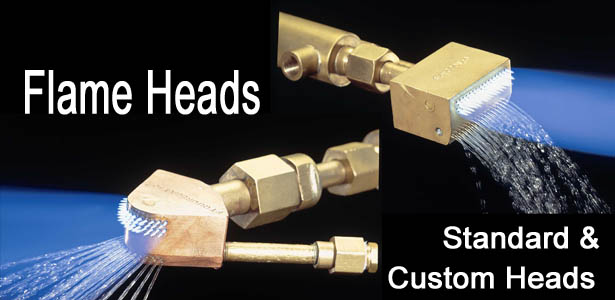It All Starts with Flame Head Design

Flame heads are to flame hardening as coils are to induction. They are the most critical component of successful flame hardening equipment, both in the design and in the careful maintenance to ensure optimal flows of fuel and oxygen.
Our flame head design process at Flame Treating Systems Inc. grew out of years of research at Dow Chemical. Our founder, Merv Sirrine, learned flame head design at Dow when the lab there investigated designs for the most optimum flows of its proprietary MAPP gas. Through research and experimentation, the technicians in the Dow lab came up with design parameters that maximize flame heads for efficiency and effectiveness.
They determined that the best volume for fuel and oxygen to go through each port for optimum burning efficiency was 500 feet/second. That translates into the actual cubic feet per hour of the gas being used, so you can calculate the correct flow rates for that particular flame head. The number of flame ports times 500 feet/second gives you the fuel and oxygen rate that’s optimal for burning quality.
The ports of flame heads can be sized differently depending on the heat specifications for a given part, changing the equation for the flow rates. Feed ports and water cooling jackets are sized to achieve the desired temperatures at the correct column. In addition, port design determines the stability of the flame so it helps eliminate the potential for backfire and dangerous leaks.
FTSI’s experience and knowledge in designing and building flame heads mean that our flame hardening machines deliver consistent, reliable flame for consistent, reliable results. Knowing the critical components in design is only half the process; manufacturing effective flame heads is a painstaking task requiring a high degree of machining expertise and attention to detail. Incorrect machining of ports can create spurs that could potentially cause dangerous blockages of fuel or oxygen.
We manufacture flame heads of either brass or copper depending on the design requirements of the parts being hardened. If the part surrounds a flame head, exposing it to a lot of secondary heat, we use copper to conduct the heat away from the flame ports. These type heads are the exception. More typically, flame heads are made out of brass because they will be located outside the surface of a part, directing the heat away from the head.
There are two styles of flame heads: water-cooled heads when the application requires only heat (which means the quench is separate, usually in a tank), and water-quenched heads that combine quench with the heat application. Water-cooled heads are used in spin hardening and stationary hardening; water-quenched heads work in progressive and combination hardening. Each head is designed to harden the specified area of a customer’s part to the depth and hardness level required.
When the flame head incorporates quench, as in progressive and combination hardening, the ports for the quench are directed at an angle away from the flame ports so that the heat can be absorbed evenly by the part before the quench process begins to cool it. In some instances, to delay the cooling even further, we can design separate quench heads to follow the flame heads.
Flame port size for fuel and oxygen can be in different sizes depending on application, anywhere from 25 thousandths in diameter up to 50 thousandths. Sometimes we put counterbores in and sometimes not, depending on whether that makes sense as a way to change the quality of the cone (making it longer or shorter) to achieve the result specified in the heat spec. We can manipulate these ports as needed to meet any spec.
Maintenance
Flame head maintenance basically consists of keeping them clean. You don’t want the flows of fuel and oxygen hampered in any way. Flame head cleaning needs to be done by a trained machinist who knows how to work with a soft metal like brass. You don’t want to enlarge any flame ports because that changes the function of the resulting flame, changing the heat application itself. We find that many clients think cleaning flame heads is just a matter of poking something through the ports to clear obstruction and trash, but we see many flame heads returned to our shop for repair after being ruined by careless cleaning. We recommend that clients send their heads to us for cleaning, but we also do repairs on heads that are inadvertently damaged or experience other flow issues that can arise over time with production level use.
Next week we’ll get into more details about using the flow controls to manage the velocity of your flame, which controls the amount of heat going into the part. That’s where the rubber meets the road. Until then, let me know how we can help you with your heat treating and flame hardening needs. Email me at mark@flametreatingsystems.com or call 919-956-5208. Happy flame hardening!






